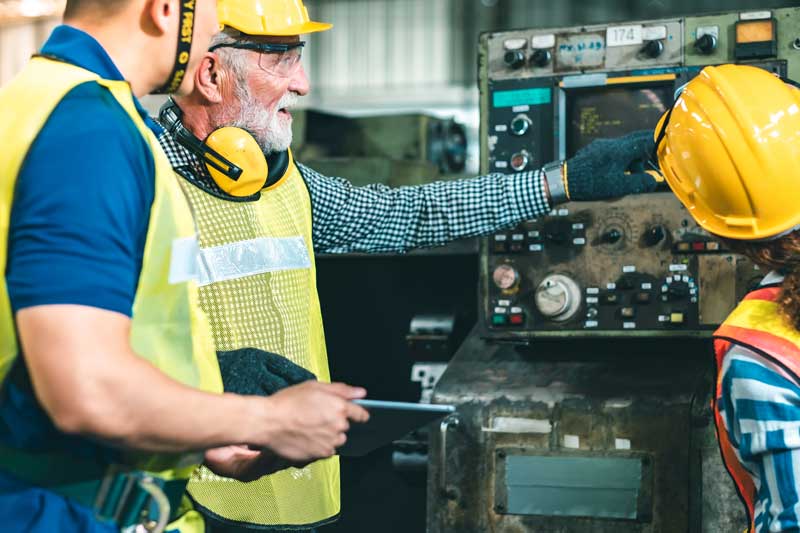Production counters are instruments used to track the number of units produced and the rate at which they are produced during manufacturing processes such as injection molding, extrusion molding, or other production activities. The main reason why manufacturers have been using these instruments has to do with improving the overall efficiency of their production lines and making them more productive. Yet, the principle of counting and monitoring the production flow is not new. However, technology enables manufacturers to streamline the production line through the use of advanced systems, such as multipurpose sensors and visible counter displays.
Production counters can help you improve your OEE and productivity in your manufacturing processes.
What are Production Counters?
As mentioned, the idea of a production counter is far from being a novelty. Counting systems in production have always been part of monitoring and improving the overall manufacturing operations in a plant. From manual counters to more advanced digital counter systems, keeping track of the actual count of items produced at any given time is intrinsically linked to the history of manufacturing.
Production counter and data collection
But, the 21st century has brought a new revolution to production counters: Data. Data capture, collection, and analysis can not only provide high quality information but also generate valuable metrics that can be crucial to OEE excellence. Indeed, count sensors can connect to your OEE software solution and monitor not only counts but also:
- Whether the production can meet the company’s targeted goals
- The expected time when the target can be met based on takt time
- The overall downtime and pace time
- A real time feedback system of the production processes
- A solution that can collect and save data for more efficient production management
- And other metrics such as inventory count, actual vs. real production, etc.

Why use a production counter with your OEE process?
Every production line’s goal is to produce items customer demands both in terms of quality and timely delivery. Therefore, it makes sense to implement a production monitor solution that can provide an actual count of what is being produced against the real goal count.
That’s where production counters can make a great deal of difference. Indeed, there is more to a production counter system than meets the eye as you can utilize the count sensor to drive numerous improvements to the manufacturing productivity. Indeed, a production counter does a lot more than counting parts and items.
Production counter vs. production monitor
The total count sensor features on the production counter can also measure insightful and comprehensive data about your manufacturing process, asking essentially as a production monitor.
- A production monitor delivers input on the total count of units produced and can share information on how to improve your performance, efficiency, and overall production processes to meet the customer needs.
- A production counter essential tells you the actual count produced, typically via production counter displays set within the indoor industrial area. Counters ensures accurate and faster counting.
In other words, when you link a production counter sensor to the OEE software in place, it can automatically track additional data to help target and improve your overall equipment effectiveness and production performance.
What data can production counter sensors provide?
Via the sensor, the production counter can relay information to the OEE solution to deliver insights on:
- Overall production counting (Good count vs. total count)
- Production pace and even production pace goal assuming you input the target
- OEE and TEEP
- Overall and expected production time
- Ideal cycle time to meet takt time target for customer demand (this also requires additional input at software level)
- Etc.

How do production counter sensors work?
To be able to count the items, a production counter is equipped with proximity sensors, namely photoelectric diffuse sensors. Proximity sensors work by detecting the reflection of the sensor light when it hits the surface of an item in front of them. This ensures accurate counting for enhanced efficiency. Proximity sensors can easily identify the object regardless of its color or transparency.
At the start and the end of the scheduled production, the company needs to provide two sensors and input information about the whole manufacturing process to benefit from valuable performance insights: A total count sensor, a good count sensor, the takt time input, and the ideal cycle time input.
Production counters and lean manufacturing
As per TechTarget, “lean manufacturing is a methodology that focuses on minimizing waste within manufacturing systems while simultaneously maximizing productivity. Waste is seen as anything” that the customer is not willing to pay for because they don’t believe it adds value. Therefore, it makes sense to implement a counter system that can specifically prevent waste by closely monitoring manufacturing productivity. The five principles of lean manufacturing encompass the following:
- Eliminating unnecessary costs to drive value for the customer at the best cost for the company
- Map the entire product cycle to identify waste
- Prevent interruptions and delays by optimizing the takt time
- Set production page goal aligned with demand (pull system)
- Continue process improvement
How production counters help
Implementing a counter can help tackle some of the 7 wastes of a lean production, as explained by the Toyota Production System:
- Over-production, as the display can inform the team when the goal count is reached
- Too much waiting or idle time — hence, the role of counters in tracking stops. The counter data is helpful to help managers set production pace goal for each process.
- Over-processing — the counter display can alert people when the takt timer reaches optimum time for the best results
- Defects — Most counters can display a breakdown of count, including total count and count of good units
- Excess inventory count, which can be shown on the relevant display in the company

The importance of digital counters
The counter display is set for maximum visibility based on its environment. Relevant information to the operations is also shared via digital counter displays. Typically, in outdoor and indoor industrial plants, the most common three displays formula rules and counts:
- The expected goal count
- How much already been produced based on real time counters feedback
- Downtime or stops
Other production counter displays can also include time spent in production, current takt time, efficiency metrics, and good count, aka the number of products controlled for quality that passed the test.
The production management uses the display to monitor current progress, spot issues before they can lead to customer dissatisfaction or money loss, and adjust production pace goal accordingly.
Production counters and OEE Performance Management Software for optimal production
A production counter system is designed to preserve your operations by tracking relevant data to help:
- Reduce waste
- Meet customer needs and expectations
- Manage costs
- Optimize inventory
- Set optimal pace goal for production
- Save productivity efforts
At OEEsystems International, we are a leading expert in managing the overall equipment effectiveness of your operations. Your OEE score is an indication of how well utilized your production resources are. As such, we are keen to recommend implementing reliable production counters that can help bring your manufacturing operations to the next level. If you wish to find out how investing in counters can support your OEE, don’t hesitate to reach out to our team of experts.
